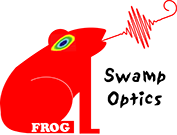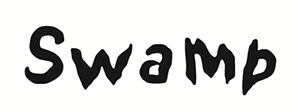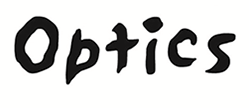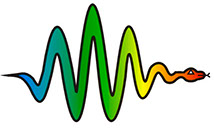Frequently Asked Questions
FROG and GRENOUILLE
What is FROG?
FROG is universally considered the most reliable ultrashort-pulse-measurement technique. It measures the time-dependent intensity and phase of an ultrashort pulse.
What is GRENOUILLE?
A simplified FROG device, GRENOUILLE is similarly reliable and combines full-information pulse measurement with experimental simplicity. GRENOUILLE operates alignment-free, requires only a few simple optical elements, and features an operating range that nicely includes that of most ultrafast Ti:Sapphire lasers and amplifiers. It also measures spatio-temporal distortions and generally includes a spatial-profile monitor, as well. In addition, it naturally operate single-shot but can also accumulate the trace over many shots.
What is a UPM device? And is it different from a GRENOUILLE?
Newport Corporation was once a worldwide distributor for GRENOUILLE devices, Newport sold them under the rather uncreative name, UPM (Ultrashort Pulse Measurement). Also, Newport offered GRENOUILLEs in any color you wanted, as long as it was black. UPM and GRENOUILLE model numbers, specifications, and capabilities are identical; only the product name differs. However, numerous device improvements have been implemented in Swamp Optics' FROGs and GRENOUILLEs since the days of Newport.
What has been the previous method for measuring or characterizing laser pulses?
Autocorrelation was the first technique used to measure the intensity vs. time of an ultrashort laser pulse. Invented in the 1960s, autocorrelation uses a laser pulse to measure itself, splitting the pulse into two, variably delaying one with respect to the other, and spatially overlapping them in some instantaneously responding nonlinear optical medium. Autocorrelators have severe limitations: at best, they yield a poor measure of a laser pulse’s width, and, worse, they say nothing at all about the pulse’s phase or spatio-temporal distortions. Moreover, no algorithm exists for retrieving the pulse intensity or any other information from an autocorrelation. Finally, they tend to under-estimate pulse lengths due to the presence of a coherent artifact.
What makes FROG and GRENOUILLE better than other measurement methods?
Unlike autocorrelation, FROG and GRENOUILLE measure the complete pulse intensity and phase vs. time (and the spectrum and spectral phase) and do not require any assumptions about the pulse shape. FROG and GRENOUILLE also have many additional advantages. They combine this full-information pulse measurement with much-needed experimental simplicity. GRENOUILLE has few elements and so is inexpensive and compact. They also operate single-shot or multi-shot. And due to its thick nonlinear-optical crystal, GRENOUILLE is more sensitive than an autocorrelator. In addition, several feedback mechanisms on the measurement accuracy that are already present in the FROG technique work with GRENOUILLE, allowing confirmation of—and confidence in—the measurement. And most Swamp Optics' FROGs and GRENOUILLEs also measure the beam spatial profile. Even better, they measure the most common spatio-temporal pulse distortions, spatial chirp and pulse-front tilt. But best of all, Swamp Optics' FROGs and GRENOUILLEs are extremely simple to set up and align: they involve no beam-splitting, no beam-recombining, and no scanning of the delay, and so have zero sensitive alignment degrees of freedom.
Keep in mind that many techniques have been proposed over the decades for measuring pulses. Most don't work at all and have many nontrivial ambiguities. In other words, they yield a pulse, but, as in autocorrelation, many different pulses correspond to the same measurement, so your pulse could be any of a number of different pulses; you just never know which. This is not acceptable in measurements in other fields, so it shouldn't be in pulse measurement either. It's just that that was the best that could be done for many years, so some people still think it's acceptable. We don't. e think that you shouldn't either.
How do I interpret the GRENOUILLE specs to choose the correct GRENOUILLE for my pulse?
Several of the specs are self-explanatory, such as the sensitivity. But interpreting the temporal resolution, spectral resolution, temporal range, and spectral range require some thought. When you make a complete pulse measurement, as you do with GRENOUILLE, you must consider the resolution and range in both the time and frequency domains. The GRENOUILLE temporal range should be a factor of two or more greater than your pulse-length. Also, the GRENOUILLE spectral range should be a factor of two or more greater than your spectrum. Also, the temporal and spectral resolutions should both be a factor of two less than your pulse's smallest structure in each domain. Be careful, however, in trying to estimate the error in the case that you're near a resolution limit: the spectral broadening due to the spectral resolution is described by a convolution, but the temporal broadening is not, and we've found in both measurements and simulations that the temporal broadening is less than would occur if a convolution applied.
How reliable are FROG and GRENOUILLE?
FROG is rigorous, general, and relatively simple to implement, and it has become a very successful technique. The shortest pulse ever generated at the time of this writing was measured using FROG. Indeed, autocorrelation measurements (interferometric or otherwise) are no longer acceptable to claim a world’s record short pulse. GRENOUILLE is a simplified version of FROG and has similar performance, although it can’t be used for pulses shorter than ~20fs. Fortunately, Swamp Optics offers a FROG for measuring pulses as short as 9fs and has a kit product for pulses as short as 4fs.
Do FROG and GRENOUILLE require any assumptions about the pulse shape?
Absolutely not! FROG and GRENOUILLE yield the pulse intensity and phase vs. time (and vs. frequency), even for complex pulses.
A paper in Optics Letters (Yellampalle, et al., Dec. 2007) claimed that FROG and GRENOUILLE have ambiguities involving pulses with substructure. Is this true?
No. The authors of that paper miscalculated the rms different between the FROG traces by about a factor of 1000, leading them to draw completely erroneous conclusions. The Trebino group published a Comment to Optics Letters on this issue after an anonymous referee confirmed that the Yellampalle, et al., paper was wrong. The matter is universally considered to be settled, and, since the Trebino group Comment appeared, no one has referenced the above erroneous paper, and that group has ceased publishing papers on this subject.
Can measuring only the autocorrelation and spectrum (the so-called TIVI and PICASO methods) determine a pulse intensity and phase?
Occasionally this works; usually it doesn’t. You never know. In general, such methods have many nontrivial ambiguities. Imagine a thermometer whose temperature reading might or might not be right…
I have an autocorrelator and spectrometer; must I buy a FROG or GRENOUILLE?
No! Just place the spectrometer behind the autocorrelator, and measure the spectrally resolved autocorrelation, and you'll have a FROG. You can then just buy a FROG software package or download a fee one from the Trebino group web page. We just saved you a bunch of money (not to mention the benefit to your research from such improved measurements)! Of course, it won't be a GRENOUILLE, so you'll have to baby-sit it quite a bit more than a GRENOUILLE.
Another company’s pulse-measurement device requires the entire beam to operate. Is this true for FROG and GRENOUILLE?
No! Swamp Optics' FROGs and GRENOUILLEs are more sensitive than other pulse measurement methods. GRENOUILLE, for example, requires only about 10 milliwatts of average power from a Ti:Sapphire oscillator and about 100 microwatts from a regen.
Is there an ambiguity in the direction of time in GRENOUILLE?
Yes, this is the case in all SHG-based pulse-measurement devices. Unlike autocorrelation, which has unaccountably many ambiguities, the direction-of-time ambiguity is essentially the only one in GRENOUILLE. If you’d like to remove it, just place an etalon in the beam before the GRENOUILLE [this is the POLKADOT (Procedure for Objectively Learning the Kalibration And Direction Of Time) option, which you can implement yourself easily. Or just call us and we'll show you how. You can check out our paper on the subject: E. Zeek, A. P. Shreenath, M. Kimmel, and R. Trebino, "Simultaneous automatic calibration and direction-of-time removal in frequency-resolved optical gating," Applied Physics B (Lasers and Optics) B74(Suppl.), p.S265-71, (2002).
I understand that optics, crystals, and cameras aren’t so broadband that one GRENOUILLE will work for all wavelengths, but will there be GRENOUILLEs for other wavelength ranges?
Yes. In fact, GRENOUILLEs for visible and the mid-infrared wavelength range are possible. Let us know, and we'll see if we can work with you to build one.
What does the name “GRENOUILLE” mean?
GRENOUILLE stands for “GRating Eliminated No-nonsense Observation of Ultrafast Incident Laser Light E-fields.” It’s the French word for “frog.” We’ve chosen it to honor all the great French and French-speaking scientists who have contributed to the field of ultrashort laser pulse measurement, including Claude Froehly, J. A. Giordmaine, and Jean-Claude Diels.
How compact is GRENOUILLE?
So compact that you can carry it in your hip pouch in most cases. The GRENOUILLE Model 8-50 USB, for example, measures 33 cm x 4.4 cm x 11.5 cm and weighs just 1.2 kg. GRENOUILLE's highly portable size is important because you never know when you might have to measure an ultrashort laser pulse! For full specifications, see the GRENOUILLE specs of the device you're considering.
Will I need an all-day intensive training session to use a Swamp Optics FROG or GRENOUILLE?
No! Setup is straightforward and takes less than 10 minutes on average. (See the FROG & GRENOUILLE page.)
Will I need a specialist to come and set up a Swamp Optics FROG or GRENOUILLE?
No! A simple setup procedure and clear instructions make this an easy, do-it-yourself job.
Pulse Retrieval
Okay, so FROG and GRENOUILLE yield the intensity and phase vs. time. How about the spectrum, spectral phase, and group delay?
Simply Fourier transforming the time-domain electric field (fully determined by the intensity and phase vs. time) yields their frequency-domain equivalents, the spectrum and spectral phase. The derivative of the spectral phase is the group delay. The FROG software gives all of these quantities, except the group delay, which is easily calculated from the spectral phase. We can put it in the code if you like.
Can I use FROG or GRENOUILLE without buying the FROG software?
Yes! The FROG trace is a spectrogram of the pulse, a measure often preferred to the intensity and phase (especially in acoustics). Its horizontal width is a measure of the pulse width; its vertical width is a measure of its spectral width; and its area is a measure of the time-bandwidth product. You can, for example, align your laser in real time for the shortest pulse length by minimizing the horizontal width.
Why do I need the FROG software to determine the pulse intensity and phase when there is no such software to buy with an autocorrelator?
There is no software for an autocorrelator because it’s impossible to determine the intensity or phase from an autocorrelation trace. The autocorrelation doesn’t contain enough information to determine these quantities. The FROG trace, on the other hand, does. Of course, as we said above, you can use FROG or GRENOUILLE without the software, and you still have a lot more information than there is in an autocorrelation.
I’ve heard that the FROG software is complicated. Is this true?
Yes, the code is complex, but using it isn’t. Your web browser is also a complex piece of code, but it’s also easy to use. The FROG code has a lot less bugs, however!
FROG & GRENOUILLE vs. Other Techniques
How do FROG-based devices, like the GRENOUILLE, compare to SPIDER?
There is really only one point to be made here. Unlike FROG, SPIDER only measures the coherent artifact. See the tutorial on this subject in our Tutorials section. As a result, SPIDER cannot distinguish between a train of short simple stable pulses and one of long, complex, and unstable pulses. That is a very serious problem that FROG and GRENOUILLE do not have. Everything else below is irrelevant, in comparison. The same is true for essentially all other alternative techniques that are currently available. Unfortunately, we get these questions from time to time, so we'll answer them here anyway. But you really don't need to read past this paragraph.
If you'd like more information about SPIDER, consider this: experimentally, SPIDER is really a FROG, but with a Michelson interferometer added to one arm and a pulse-stretcher added to the other. So it's simply a FROG, but with two very complicated devices added to it. Due to the Michelson interferometer, SPIDER is interferometric and so is very alignment-sensitive and instability-sensitive. Worse, in all, it has multiple interdependent and sensitive alignment knobs, which can take a day (or longer!) to align and which must be constantly realigned as the beam walks, the pulse changes, or the room temperature drifts. GRENOUILLE, on the other hand, is non-interferometric, has no sensitive alignment knobs, and remains aligned forever.
In terms of sensitivity, how do GRENOUILLE devices compare with SPIDER?
GRENOUILLE is significantly more sensitive than SPIDER. SPIDER requires the entire beam of a Ti:Sapphire laser in order to make a measurement. GRENOUILLE requires only a few per cent of it. This allows GRENOUILLE to operate as a monitor, while using the beam for something useful. SPIDER cannot do this, as it requires the entire beam power.
Can SPIDER show the spatio-temporal distortions that GRENOUILLE can detect?
No. SPIDER does not measure the spatio-temporal distortions, like spatial chirp and pulse-front tilt, that Swamp Optics' devices like GRENOUILLE detect. And SPIDER also doesn't yield the beam spatial profile, either.
Does SPIDER measure the spectrum?
No. The spectrum must be obtained from a separate measurement when using SPIDER.
How do SPIDER and FROG confirm their measurements?
SPIDER does not offer any confirmation that a measurement is correct. You just have to believe it. GRENOUILLEs (and FROGs in general) offer the retrieved trace, which must agree with the measured trace, or the measurement is wrong (which can be the case if the train of pulses has variations in it, or if the spatial mode quality is really bad).
Can SPIDER measure complex pulses?
SPIDER cannot measure complex pulses, i.e., pulses with time-bandwidth products (TBPs) greater than about 2. GRENOUILLE can measure pulses with TBPs up to about 10 - 30 (although this depends on the pulse length and model).
Is there any advantage to using SPIDER over GRENOUILLE?
No, there's no advantage to SPIDER over GRENOUILLE. In the early days (~20 years ago), the FROG algorithm was slow (taking up to a minute to converge), and SPIDER's inversion algorithm was faster. But performance improvements in the FROG code and vast improvements in computer speeds have eliminated SPIDER's only (short-lived) advantage.
How widespread is the use of FROG vs. SPIDER, and how reliable have each approach proven?
FROG and GRENOUILLE are used in thousands of labs worldwide and have been available for over two decades. They are therefore much more established than SPIDER, which is used in only a few labs, mainly in Europe, and that number is decreasing with increased awareness that SPIDER only measures the coherent artifact.
Swamp Optics
What is Swamp Optics?
Atlanta-based Swamp Optics develops, markets, and supports ultrashort-laser-pulse measurement devices. Swamp Optics' products are used by researchers, scientists, and engineers involved in variety of endeavors for which ultrafast lasers play an important role, including materials science, electronics, and biomedical research. Swamp Optics was founded in 2001 by Rick Trebino, a leading scientist in the field of ultrafast optics and a specialist in ultrashort-laser-pulse measurement.
What is Swamp Optics’ unique value proposition?
Swamp Optics’ products incorporate FROG and GRENOUILLE technologies, the gold standards for accurately determining critical pulse information (in particular, the intensity and phase vs. time and frequency). Invented by Swamp Optics’ founder, FROG and GRENOUILLE are the subject of several patents. They are rigorous, general, and accurate, and it is a widely used technique with many applications. Swamp Optics' products are the only devices available to fully characterize a single ultrashort laser pulse, yielding the pulse’s time-dependent (or, equivalently, frequency-dependent) intensity and phase, plus spatio-temporal distortions (spatial chirp and pulse-front tilt), absolute wavelength, and the beam spatial profile.
What are Swamp Optics’ offerings?
Swamp Optics’ flagship product is GRENOUILLE (pronounced gra-NEW-ee), a highly compact FROG device combining full-information pulse measurement with experimental simplicity; GRENOUILLE operates alignment-free, uses only a few simple optical elements, and requires no more than about ten minutes to set up. It features an operating range that includes that of most ultrafast Ti:Sapphire and solid-state lasers and amplifiers. Multiple GRENOUILLE products are available, including the Model 8-20, for pulses as short as 20 femtoseconds (fs), and the Model 8-50, for pulses as short as 50 fs.
What are typical applications for Swamp Optics products?
Ultrashort laser pulses—pulses with durations of about a nanosecond or less—have many applications in biology, chemistry, physics, and electrical engineering. They commonly serve to explore kinetics in proteins and as ultrafast probes in electronic circuits, leading to the development and testing of highly advanced biomedical products, electronic circuitry, and semiconductors.
To produce the desired final ultrashort pulse shape, laser pulses are routinely dispersed, stretched, and eventually compressed to their shortest possible width. The process typically introduces significant phase distortions and spatio-temporal distortions—like spatial chirp and pulse-front tilt—and other flaws that can seriously impair research data. Until recently, these distortions were difficult, if not impossible, to measure.
With the introduction of Swamp Optics' FROG and GRENOUILLE devices, comprehensive characterization of ultrashort laser pulses has become accurate and easy. FROG traces and software yields the precise pulse intensity and phase vs. time and the pulse spatio-temporal characteristics.
How are Swamp Optics products distributed?
All Swamp Optics FROG and GRENOUILLE products are available for purchase directly from Swamp Optics and are also available from a number of distributors. See the How to Buy page.
Do you have international distributors?
Check out our How to Buy page to find international distributors. If your country is not covered, contact us directly at info@swampoptics.com.
Copyright © 2022 Swamp Optics, LLC. All Rights Reserved.



